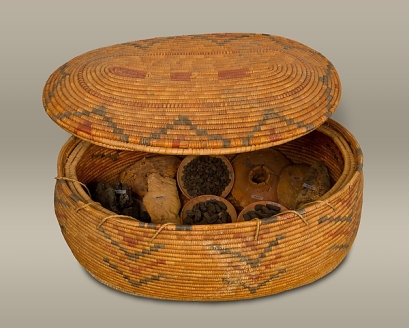Creativity
For as long as textiles have been created – whether by braiding, felting or weaving – craft-workers have been combining the functional requirements of the cloth with creative ideas. This may have been to enhance the textile’s warmth or strength, to introduce different fibres, or to change the look of the textile with new dyes, pattern weaves, manipulation or sewing techniques, but I find it inspiring to consider just how inventive these early crafters were. In cultures around the world and across thousands of years, there have been artisans – their names now long forgotten – who have not only provided us with practical solutions as diverse as woven baskets, felted boots and card woven bands, but have devised ways to make them exquisitely detailed and beautiful.

Grass storage basket from the 18th Dynasty reign of Thutmose II, 1492–1473 BCE

Felt boots from one of the Pazyryk Tombs in Mongolia, 300 – 238 BCE

Fragment of Merovingian card weaving from France, 7th century
Howard Gardiner is a contemporary psychologist who has written at length about creativity, and he points out that for many creative people, the ground-breaking leaps of imagination are rare in life. They spend most of their time applying their skills to all kinds of small everyday problem solving, and this incremental ‘practice’ seems to prepare them for the moments of great inspiration and novelty when big ideas do come along. (3)
It’s easy to see how this could have applied to weavers in pre-modern eras, when the spinning of yarn and production of cloth would have been time-consuming activities. The ‘everyday problem solving’ might have been for labour-saving efficiencies or durability of wear. But there is plenty of evidence to suggest that it might have been just as much for artistic expression – to make their work more interesting and enjoyable to create, and to produce a beautiful product that would be appreciated when it was done.
This seems to be the view of Elizabeth Barber, who describes how elaborate the weaves were in Bronze Age and Iron Age textiles. “Whenever we catch a glimpse of central European fabrics they are fancy … plaids and checkers on top of zig zag and diamond twills” (1). They were also finished with highly ornamental borders and embroidery. Barber suggests that this pride in craftsmanship was consistent with the care which would have been taken by others in the making of sculpture and the decoration of pottery. Because of the perishability of cloth, though, this artistry has not always been as recognized. And yet, Barber points out, not only in Europe but across Asia, Africa and the Americas, ancient textile workers “have been pouring their creativity of design into the cloth that they needed to make anyway for a hundred household uses.” (2)
… and Inspiration
In a way, I see it in my own working as well. Each project suggests the next, and unexpected discoveries lead to new ideas.
The Christmas holiday has been a wonderful chance to be at home with family, friends and neighbours. It has also meant that for a few weeks I am re-united with my loom and can finish warping up the work that I abandoned back in September. I don’t expect I’ll have time to finish weaving this scarf before I leave for Cambridge again, but I have made some progress!

The warp is bamboo in two shades of blue, with a sett of 16 epi. And the weft is a fine silk-wool blend. I was a bit spontaneous in deciding on a weave structure this time. Obviously there’s a diamond twill there, but with a border of point twill along the selvages and a symmetrical combination of bigger and smaller diamonds interlocked.
I have decided to improvise a little now, and for the next few projects move progressively further away from the designs which have been found in archaeological textiles. This will mean trying out some interesting variations based on the basic building blocks of tabby, twill, check and stripe. For example, in the past few months I have been captivated by the knitting of Kaffe Fassett. His work is a wonderful example of exuberant creativity! So my next challenge is to translate his vividly warm colours, patterns and textures into my own weaving.

Image credit: Pinterest
References
(1) Barber, E. Prehistoric Textiles. Princeton: Princeton University Press. (p 293)
(2) Barber, E. Prehistoric Textiles. Princeton: Princeton University Press. (p 298)
(3) Gardiner, H. Creating Minds. New York: Basic Books/Harper Collins.
Archaeological Images
http://images.metmuseum.org/CRDImages/eg/web-large/36.3.57a-b_EGDP011891.jpg
http://depts.washington.edu/silkroad/museums/shm/hermitagepazyryk37a.jpg
http://alfalfapress.com/suvia/wp-content/uploads/2011/03/card-band-chelles-2-300×50.jpg

I am really impressed with the way you have presented this wonderful article. Thank you for sharing this great article.
LikeLike